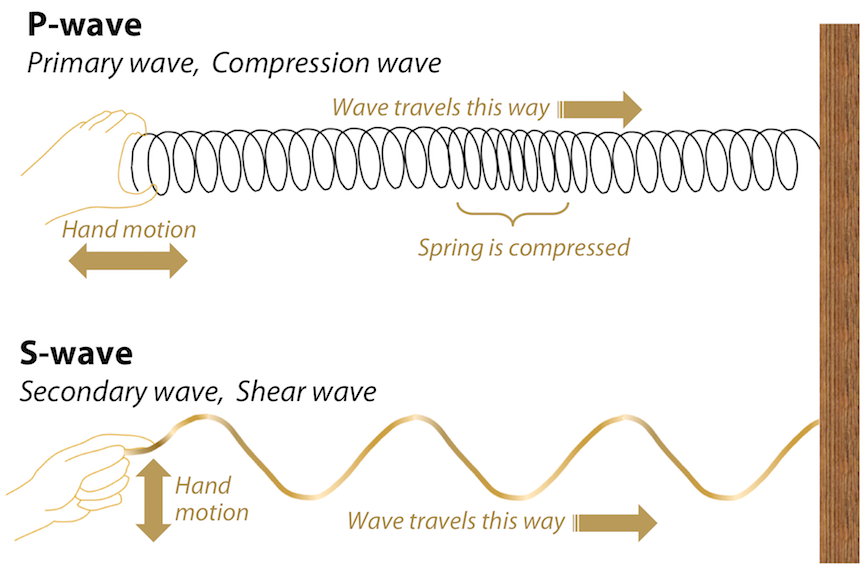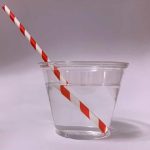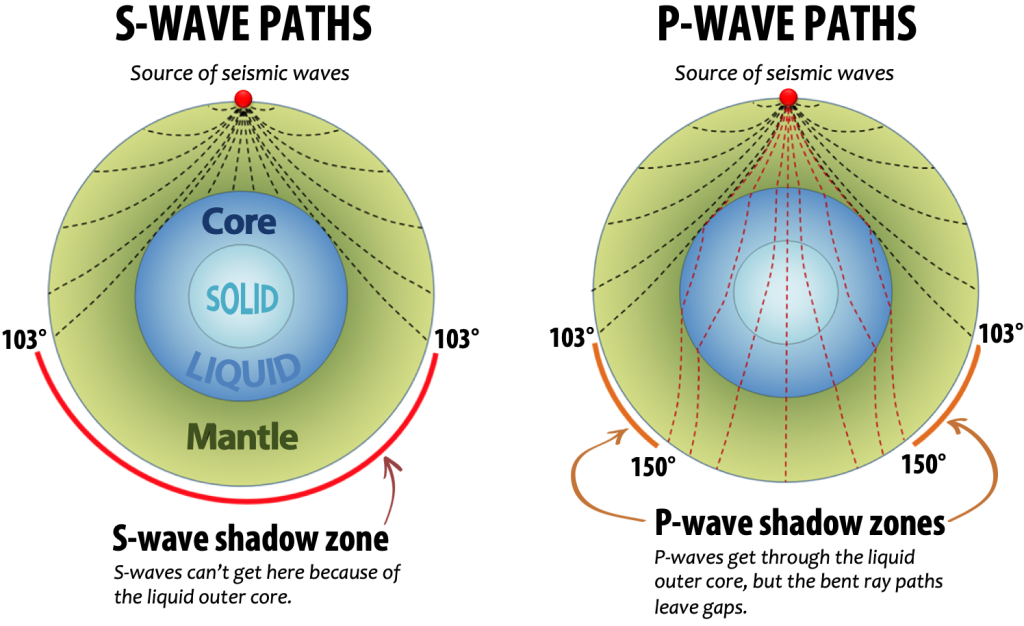3. Seismic Waves
The shaking from an earthquake travels away from the rupture surface in the form of seismic waves. Seismic waves are measured to find the location of the earthquake, and to estimate the amount of energy released by the earthquake (its magnitude). Seismic waves are organized into two categories, body waves and surface waves, according to where they travel and how they move through materials.
3.1 Body Waves
Seismic waves that travel through Earth’s interior are called body waves. They move through the body of the Earth. They are further distinguished as either P-waves or S-waves.
P-waves are body waves that move by compression, in that they alternately compress and stretch materials in the direction they are moving. This is the same motion seen if you attach one side of a slinky to a wall, stretch it out and give it a push. You would see the coils of the slinky compress and stretch out again behind as that wave of compression travelled from your hand to the wall (Figure 1B.3.1, top image). The “P” in P-wave stands for primary because P-waves have the fastest velocity of all seismic waves are therefore the first to arrive and be detected at a seismic station (monitoring station) when an earthquake occurs.
S-waves are body waves that move with a shearing, or side to side motion. This would be the motion seen if you attach one end of a rope to the wall then give the other end a flick up/down or side to side. You would see an “S” pattern travel down the length of the rope to the wall (Figure 1B.3.1, bottom image). The “S” in S-wave stands for secondary (not shear, although that is a helpful way to remember the motion it has!), because S-waves are slower than P-waves, and therefore arrive at a seismic station second, after the P-waves.

The nature of compression means that P-waves can travel through both solids and liquids. S-waves, however, can only travel through solids. They cannot travel through liquids. The shear motion of an S-wave cannot propagate through a liquid as the liquid molecules are too spread out to carry any shear motion forward. This video clip simulating the motion of P and S waves through a line of people can be used to help visualize why S-waves cannot travel through liquids.
P-waves and S-waves can travel rapidly through geological materials, at speeds many times the speed of sound in air. Measuring the travel speeds and time differences between the P and S wave arrival times at seismic stations is how we learn information about the interior of the planet – turns out it is quite a hard place to get to!
Imaging Earth’s Interior using Seismic Waves
When seismic waves meet a different rock layer, some might bounce off the layer (reflect) like light hitting a mirror while other waves will travel through the layer, but bend or change direction (refract) as they enter the new layer, like light as it moves from the air into water (see straw in the image to the right, Figure 1B.3.2).

Seismic velocities are higher in more rigid layers, so broadly speaking, they get faster deeper within Earth, because higher pressures make layers more rigid. This density change causes waves to take curved paths through the Earth because refraction bends their path until they are reflected and directed upward again.
Crust-Mantle Boundary
One of the first discoveries about Earth’s interior made through seismology was in the early 1900s by Croatian seismologist Andrija Mohorovičić (pronounced Moho-ro-vi-chich). He noticed that sometimes, seismic waves arrived at seismic stations farther from an earthquake before they arrived at closer seismic stations. He reasoned that the waves that traveled farther were faster because they bent down and traveled faster through different, denser rocks (those of the mantle) before being bent upward back into the crust (Figure 1B.3.3). The arrows on this diagram represent seismic waves. Even though they travel in all directions from their source, it is convenient to imagine the path traced by one point on the wave front and represent that path as a line in diagrams.

Mohorovičić identified a distinct velocity difference at a consistent depth in the Earth, depending on location, which corresponded to a distinct rock and density change. This is the boundary between the crust and the mantle and is now known as the Mohorovičić discontinuity (or Moho). Its depth is between 60 – 80 km beneath major mountain ranges, 30 – 50 km beneath most of the continental crust, and 5 – 10 km beneath ocean crust.
Core-Mantle Boundary
Arguments for a liquid outer core were supported by a distinctive signature in the global distribution of seismic waves from earthquakes. When an earthquake occurs, there is a zone on the opposite side of Earth where S-waves are not measured. This S-wave shadow zone begins 103° on either side of the earthquake, for a total angular distance of 154° (Figure 1B.3.4, left). There is also a P-wave shadow zone on either side of the earthquake, from 103° to 150° (Figure 1B.3.4, right).

The S-wave shadow zone occurs because S-waves cannot travel through the liquid outer core. The P-wave shadow zone occurs because seismic velocities are much lower in the liquid outer core than in the overlying mantle, and the P-waves are refracted in a way that leaves a gap. The shadow zones tell us that the outer core is liquid, and the size of the shadow zones allows us to calculate both the size of the core and the location of the core-mantle boundary.
3.2 Surface Waves
When body waves reach Earth’s surface, some of their energy is transformed into surface waves, which travel along Earth’s surface. Two types of surface waves are Rayleigh waves and Love waves (both named after the scientists who first described them).
Rayleigh waves (R-waves) are characterized by retrograde circular motion in a forward direction (Figure 1B.3.5, left side). That description is a bit of a mouthful but think of a ball spinning in a backwards direction but being pushed forward. These waves make the ground surface roll like ocean waves. In fact, a common description following a large earthquake is that of the ground rolling like waves and feelings of seasickness.
Love waves (L-waves) are characterized by side-to-side motion of the Earth’s surface (Figure 1B.3.5, right side). This is the same motion of a snake slithering across the ground – only it is the ground doing the slithering!
Surface waves are slower than body waves and are detected after the body waves. Surface waves typically cause more ground motion than body waves, and therefore do more damage than body waves. The effects of both kinds of surface waves diminish with depth (as shown in Figure 1B.3.5).

Check your understanding: Seismic waves
